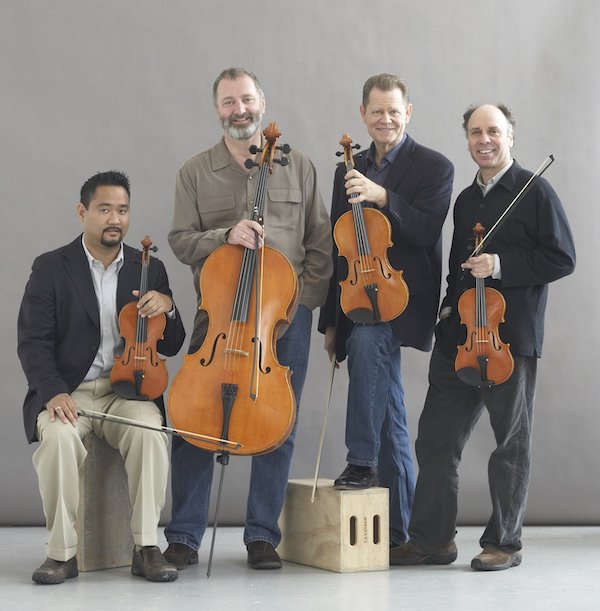Alexander Quartet brings old-school virtues to traditional program

Somewhere, there is probably still a Chinese restaurant where you order one from Column A, one from Column B, and one from Column C. And as of Wednesday, there was still a New York concert hall where you could be served three string quartets, one from Column Classical, one from Column Modern, and one from Column Romantic.
A very old-school program of Mozart, Shostakovich and Mendelssohn—for string quartet only, no tape loops, belly dancers, or rifle shots–was delivered at the Baruch Performing Arts Center by the Alexander String Quartet, a group that cultivates the old-school virtues of the genre: silky tone, blooming sonorities, and elegant four-way conversation.
Mozart began his Quartet in C major, K. 465, the last of the set of six quartets he dedicated to his friend and mentor Joseph Haydn, way out in harmonic left field, with the four instruments playing notes seemingly unrelated to each other, then magically sliding them around till they made a perfect cadence.
On Wednesday those chords–the “Dissonance” that gave the quartet its nickname–stole upon the ear, somehow more shocking for being so understated. In the ensuing Allegro, staccato triplets and running 16th-notes danced with sharply swooping lines in a genial, poised performance.
Although many of Mozart’s instrumental andantes are escapees from the opera house, he rarely used the marking Andante cantabile (singing), as in this quartet’s second movement. The Alexander players—Zakarias Grafilo and Frederick Lifsitz, violins; Paul Yarbrough, viola; and Sandy Wilson, cello—responded with sweet tone and a long melodic arc, but also much conversational detail.
The easygoing Menuetto slid through its minor-key trio with not much color change. The ensemble excelled, however, in the witty byplay of upbeats in the closing Allegro molto, which was apparently inspired by Haydn’s monothematic finales–but of course Mozart’s head was too full of tunes to make do with just one.
Shostakovich’s Quartet No. 12 in D-flat major, Op. 133, also opens with a quiet shocker, the cello playing a 12-tone row. Tongues wagged when the piece came out in 1968–Shostakovich had “gone over” to the Schoenberg side! The reality was anything but, as the sly composer fitted his wayward theme into winding counterpoint that was securely in D flat. In performance, the Alexanders went easy on Shostakovichian sarcasm, delivering the movement’s alternating themes with good humor and just a dash of pizzicato irony.
The second (and final) movement was alternately lively with staccato dialogue and fervent with a deep, dissonant hymn à la Ives. Again the players steered clear of this composer’s angry side—justifiably in such introspective music—but the movement seemed to go on for a long time as they searched for the thread to pull its episodes together.
Although no teenagers themselves, the Alexander players seemed to find a kindred spirit in the Beethoven-besotted, 18-year-old Felix Mendelssohn, whose Quartet in A minor, Op. 13, shone with a polish, poise, and zest for counterpoint that played to the ensemble’s strengths.
In Wednesday’s alert performance, after an Adagio introduction, the concise first movement bristled with stretti, then pulled back to misterioso moods. The variety of quartet textures, often featuring the inner instruments, was expertly realized.
In the Adagio non lento, a deep, fervent song bookended a long-breathed, well-paced fugue with dancing episodes. The Intermezzo first danced gavotte-like to a pizzicato accompaniment, then sped up to a fast staccato, all executed with elegance and grace.
The finale’s stark opening, with violin recitative over urgent tremolo chords, was the most Beethoven-like moment in the piece. The ensuing Presto, however, was all Mendelssohn in his fiercest con fuoco mood, which the ensemble delivered with admirable energy, pacing, and suspense. They did not, however, find a way to keep the movement’s closing pages—a reminiscence of the work’s opening Adagio—from seeming too long.
The Baruch Performing Arts Center presents Weber’s Der Freischütz in an original musical arrangement by Daniel Schlosberg, Dec. 4-15. baruch.cuny.edu/bpac; 212-352-3101.






